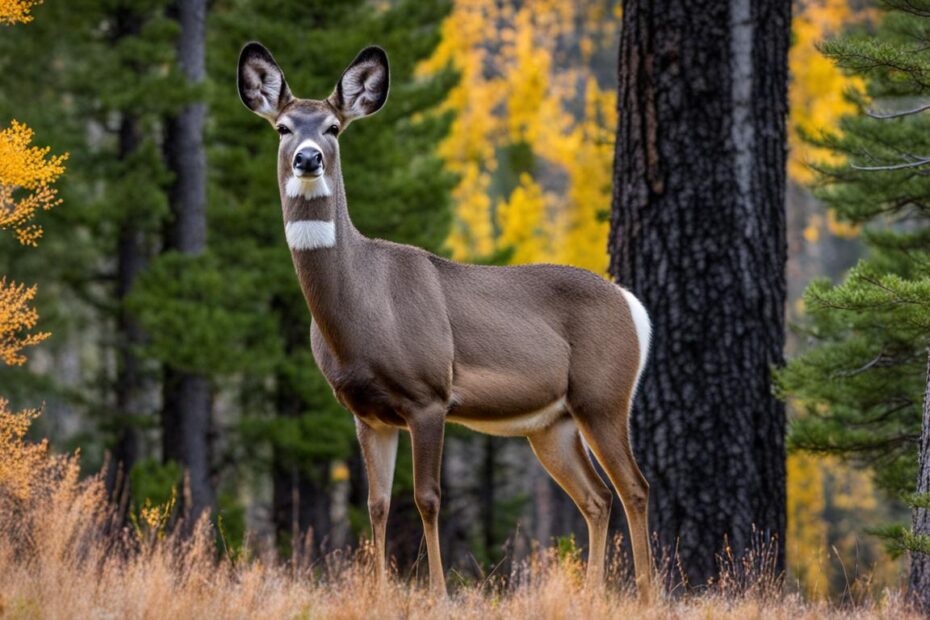Have you ever wondered how long mule deer carry their young? The gestation period of mule deer has long been a mystery, but recent research has shed light on this natural process. Understanding the duration of their pregnancy and other aspects of mule deer reproduction is essential for wildlife management and conservation efforts.
Key Takeaways:
- The gestation period for mule deer is approximately 7 months.
- Female mule deer, known as does, carry their young, called fawns, for this extended period.
- Understanding mule deer reproduction helps guide wildlife management and conservation strategies.
- Conserving mule deer populations is vital for maintaining biodiversity and ecological balance.
- Hunters play a crucial role in mule deer conservation efforts through responsible hunting practices.
Understanding Mule Deer Reproduction
Mule deer have a unique reproductive cycle that is fascinating to study. Their breeding season, also known as the rut, typically occurs in the fall. During this time, male mule deer, known as bucks, engage in aggressive behaviors to establish dominance and compete for mates. This can include vocalizations, antler displays, and physical combat. It’s truly a remarkable sight to witness the power and determination of these magnificent animals as they vie for the attention of the females.
Female mule deer, known as does, have a specific window of time during the rut when they are receptive to breeding. This period lasts for a few weeks and is determined by various factors, including environmental cues and hormonal changes. The does will choose a mate based on their assessment of the bucks’ strength and fitness, ensuring the best chances of producing healthy offspring.
The reproductive cycle of mule deer plays a crucial role in the population dynamics of the species. By having a defined breeding season, mule deer synchronize their reproductive efforts, which increases the chances of successful mating and the survival of their young. This strategy helps to maintain a healthy population and ensures the long-term viability of the species. Understanding the intricacies of mule deer reproduction is vital for wildlife researchers, managers, and conservationists in their efforts to protect and preserve these magnificent animals.
| Key Points: |
|---|
| Mule deer have a unique reproductive cycle, with a breeding season occurring in the fall. |
| Male mule deer, or bucks, engage in aggressive behaviors during the rut to establish dominance and compete for mates. |
| Female mule deer, or does, have a specific period of receptivity within the breeding season. |
| The synchronized reproductive efforts of mule deer contribute to the overall population dynamics and long-term survival of the species. |
The Mule Deer Gestation Period
Understanding the duration of the mule deer gestation period is crucial for wildlife management and conservation efforts. Female mule deer carry their young, known as fawns, for approximately 7 months before giving birth. This extended gestation period allows for proper fawn development and ensures their survival once they are born.
The mule deer gestation period is unique among deer species, as it is longer than most. The prolonged duration allows for important growth and development milestones to be reached before birth. Female mule deer carefully select suitable habitat areas to give birth, ensuring the safety and well-being of their fawns.
Female mule deer carry their young for an impressive 7 months, providing ample time for fawn development. This lengthy gestation period demonstrates the careful reproductive strategies that mule deer employ to ensure the survival and success of their offspring.
Research on the mule deer gestation period has provided valuable insights into the reproductive behavior of these majestic animals. By studying and understanding the duration of the gestation period, wildlife managers and conservationists can make informed decisions to protect and sustain mule deer populations for future generations. It is important to note that the exact length of the gestation period may vary slightly between individual mule deer, but the average duration remains around 7 months.
Mule Deer Gestation Period at a Glance
| Gestation Period | Approximately 7 months |
|---|---|
| Fawn Development | Continues throughout gestation period |
| Birth Season | Late spring to early summer |
The mule deer gestation period is a fascinating aspect of their reproductive cycle. It is a testament to their resilience and adaptability in ensuring the survival of their species in diverse habitats. By protecting mule deer populations and their habitats, we can contribute to the overall preservation of our natural ecosystems.
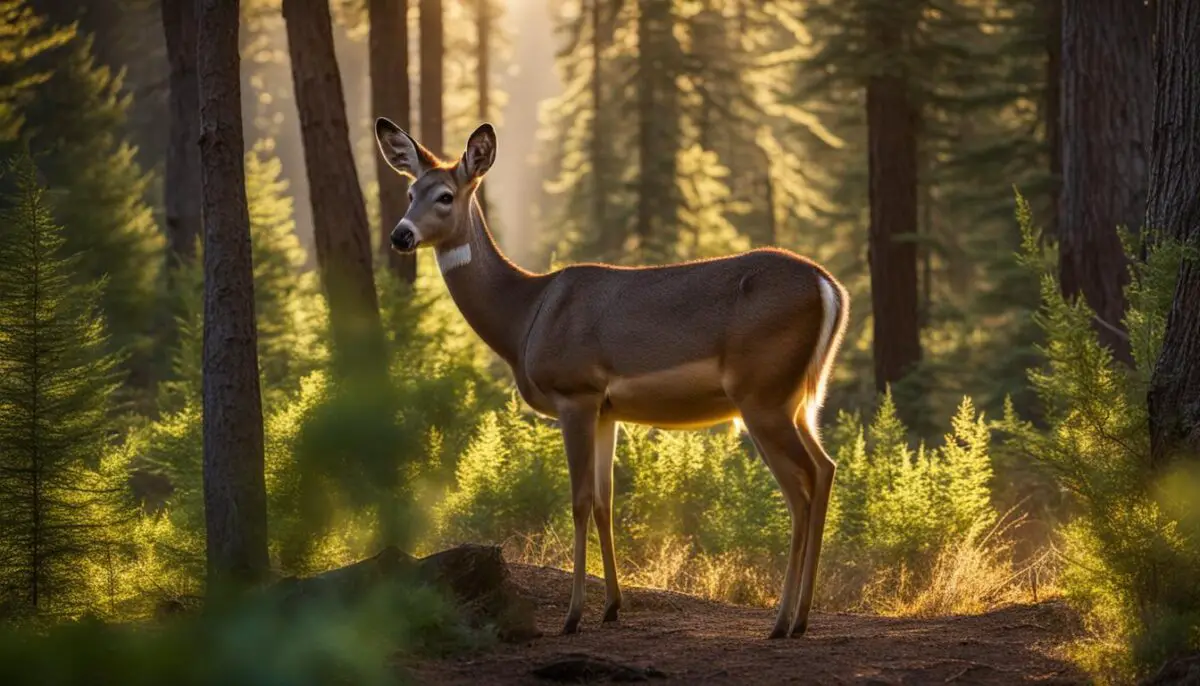
Mule Deer Fawn Development
After the 7-month gestation period, female mule deer give birth to their fawns in the late spring or early summer. The fawns are born relatively helpless and rely on their mothers for nourishment and protection. Over the first few months of their lives, the fawns go through significant development, growing rapidly and gaining strength. They begin to explore their surroundings and learn important survival skills from their mothers.
During the initial weeks, the fawns rely on their mother’s milk for nutrition, which is rich in essential nutrients to support their growth. As they mature, fawns gradually start to consume solid foods, such as vegetation, which helps develop their digestive system. This transition from a milk-based diet to solid food is a crucial milestone in their development.
The mule deer birth cycle is a fascinating process to observe. Young fawns are born with a spotted coat, which serves as camouflage and helps them blend into their surroundings. This spotting pattern gradually fades as they grow older, allowing them to adapt to their environment more effectively. Throughout their development, fawns learn important survival skills from their mothers, such as identifying potential threats, finding food sources, and navigating through their habitat.
| Mule Deer Fawn Development | Description |
|---|---|
| Birth | Fawns are born in late spring or early summer, relying on their mothers for nourishment and protection. |
| Growth and Exploration | Fawns grow rapidly, gaining strength and gradually transitioning to solid food. They begin to explore their surroundings and learn important survival skills from their mothers. |
| Spotted Coat | Fawns are born with a spotted coat, providing camouflage and gradually fading as they grow older. |
Young fawns rely on their mothers for guidance and protection as they navigate the challenges of their environment. This crucial period of development sets the foundation for their future survival and success as adult mule deer.
- Fawns are born relatively helpless and rely on their mothers for nourishment and protection.
- They grow rapidly, gaining strength and gradually transition from a milk-based diet to solid food.
- Their spotted coat serves as camouflage, gradually fading as they mature.
- Fawns learn important survival skills from their mothers, ensuring their ability to thrive in their habitat.
Factors Affecting Mule Deer Reproduction
Mule deer reproduction is influenced by various factors that play a crucial role in their population dynamics. Understanding these factors is essential for effective wildlife management and conservation efforts. Let’s explore the key factors that affect mule deer reproductive behavior and the overall reproduction cycle.
Habitat Quality
Habitat quality is a significant factor in mule deer reproduction. A healthy and well-managed habitat provides the necessary resources for mule deer to thrive and reproduce successfully. Abundant food sources, suitable cover and shelter, and access to water are all crucial elements for mule deer to engage in breeding activities and raise their young. Habitat conservation efforts play a vital role in supporting mule deer reproduction and maintaining healthy populations.
Food Availability
The availability of food resources directly impacts mule deer reproductive behavior. A well-nourished doe is more likely to conceive and successfully carry her young to term. Adequate food availability during critical periods such as the breeding season and gestation period is essential for optimal reproductive success. Changes in vegetation, land use, or climate that affect food availability can influence mule deer reproduction.
Predation and Population Density
Predation and population density are also important considerations in mule deer reproduction. High predation rates can impact mule deer survival, reducing the overall reproductive success of the population. Balancing the predator-prey dynamic and managing population density within the carrying capacity of the habitat are essential for maintaining healthy mule deer populations and successful reproduction.
| Factors Affecting Mule Deer Reproduction | Impact |
|---|---|
| Habitat Quality | Crucial for providing resources and support for reproduction |
| Food Availability | Influences doe’s ability to conceive and sustain pregnancy |
| Predation and Population Density | Affects overall survival and reproductive success |
Understanding and managing these factors is essential for ensuring the long-term survival and health of mule deer populations. By addressing habitat quality, food availability, predation, and population density, wildlife managers can promote successful mule deer reproduction and maintain sustainable populations for future generations to enjoy.
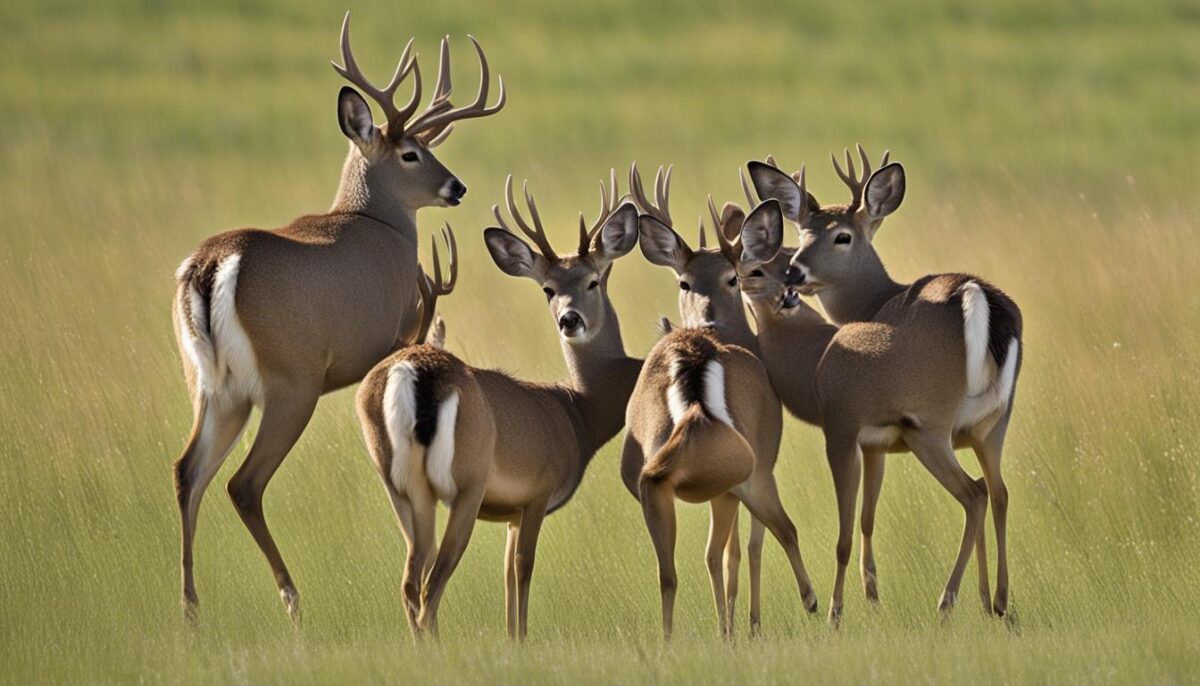
Wildlife Management Considerations:
Effective wildlife management requires a thorough understanding of mule deer reproductive behavior, particularly during the breeding season and gestation period.
The mule deer breeding season, also known as the rut, is a critical period when bucks engage in aggressive behavior to establish dominance and compete for mates. This behavior influences the success of mule deer reproduction and population growth. Wildlife managers must be aware of the timing and intensity of the rut to implement appropriate management strategies.
Further, the gestation period of mule deer, lasting approximately 7 months, affects the timing and outcome of reproduction. Wildlife managers need to consider this extended period when developing conservation plans to ensure the survival and growth of mule deer populations.
Factors to Consider in Wildlife Management:
1. Mule Deer Breeding Season: Understanding the timing and behavior of the rut is crucial for effective management. By monitoring bucks’ aggressive behaviors and the receptiveness of does, wildlife managers can assess the reproductive success and overall population dynamics.
2. Gestation Period: The 7-month gestation period directly affects the timing of fawn births and the population growth rate. Wildlife managers need to consider the gestation period when implementing hunting regulations and habitat management strategies.
3. Habitat Quality: A healthy habitat plays a significant role in mule deer reproductive success. Ensuring sufficient resources, such as food availability and suitable cover, supports mating opportunities and fawn survival.
“Understanding mule deer reproductive behavior is crucial for effective wildlife management and conservation efforts.”
| Key Considerations | Actions |
|---|---|
| Monitor the breeding season | Conduct field surveys, collect data on buck behavior, and assess the reproductive success of does. |
| Consider the gestation period | Adapt hunting regulations, implement habitat conservation plans, and protect key areas during critical periods. |
| Manage habitat quality | Implement sustainable land management practices, promote diversity in vegetation, and maintain suitable cover for mating and fawning. |
Mule Deer Reproduction and the Birth Cycle
Understanding mule deer reproduction is vital for the conservation and management of these magnificent creatures. The birth cycle of mule deer involves a complex interplay of various factors, contributing to the survival and growth of their populations.
Mule Deer Reproductive Behavior
During the breeding season, or the rut, which typically occurs in the fall, male mule deer engage in aggressive behaviors to establish dominance and compete for mates. This behavior includes vocalization, marking territory, and engaging in physical encounters with other males. The dominant bucks successfully mate with receptive females, known as does, ensuring the continuation of their species.
Once the breeding season is over, female mule deer undergo a gestation period of approximately 7 months. This period is crucial for the development of their young, known as fawns. The extended gestation period allows for proper fetal development, ensuring the fawns are born healthy and strong.
The Mule Deer Birth Cycle
After the 7-month gestation period, female mule deer give birth to their fawns in the late spring or early summer. The fawns are born with spotted fur to aid camouflage, as they are relatively helpless and rely on their mothers for nourishment and protection.
Over the first few months of their lives, the fawns go through significant development, rapidly growing in size and strength. As they gain strength, they begin to explore their surroundings and learn important survival skills from their mothers, such as foraging for food and avoiding predators.
| Stage | Description |
|---|---|
| Gestation Period | Approximately 7 months |
| Birth Season | Late spring to early summer |
| Fawn Development | Rapid growth, exploration, and learning survival skills |
Maintaining healthy mule deer populations is crucial for the overall biodiversity and ecological balance of our ecosystems. By understanding mule deer reproduction and the intricacies of their birth cycle, we can implement effective conservation strategies and ensure the long-term survival of these iconic animals.
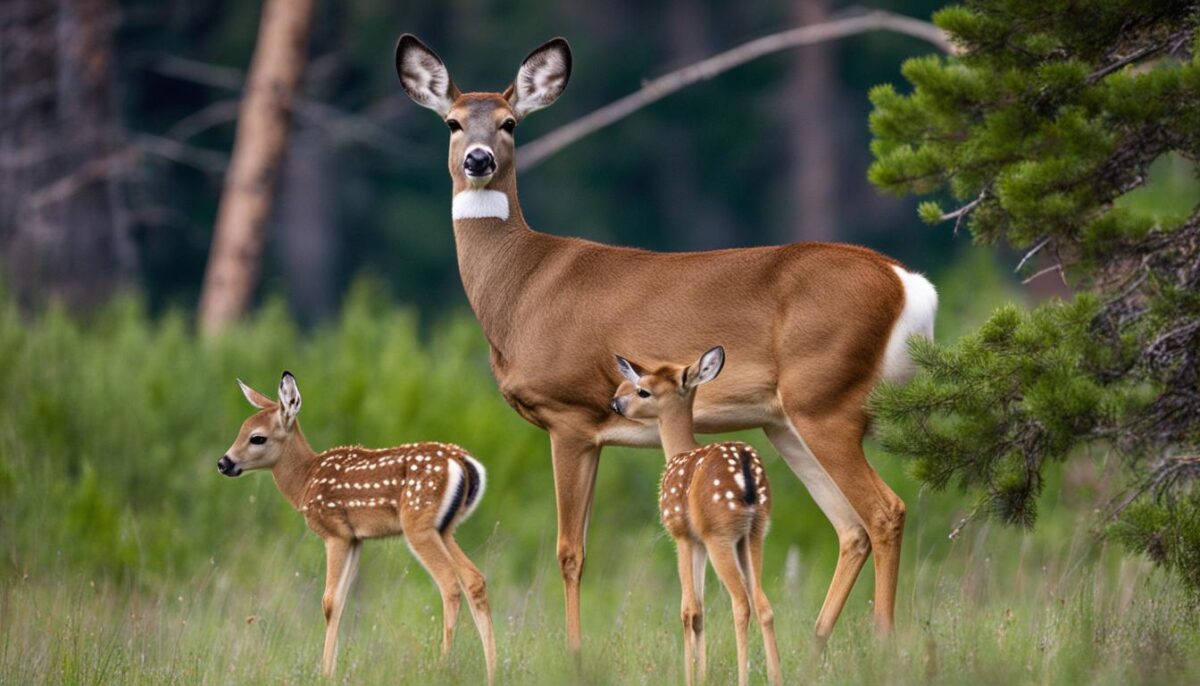
Future Research and Conservation Efforts
The study of mule deer reproductive behavior and the gestation period has provided valuable insights into their lifecycle. However, there is still much more to learn. Future research should focus on specific aspects of mule deer reproduction to further expand our understanding of this iconic species.
One area of interest is the impact of environmental factors on mule deer’s reproductive success. By studying how climate change, habitat degradation, and human activities affect their breeding patterns, scientists can identify strategies to mitigate these threats and protect mule deer populations.
Another crucial aspect to explore is the genetic diversity of mule deer populations. Studying the genetic makeup of different herds can help identify any genetic bottlenecks or inbreeding issues that may hinder their long-term survival. This information can guide conservation efforts aimed at maintaining healthy and genetically diverse mule deer populations.
Conservation efforts should also continue to prioritize the protection of mule deer habitats. By preserving their natural habitats and ensuring sustainable hunting practices, we can promote the well-being of mule deer populations for generations to come.
The Importance of Research and Conservation
“The more we learn about mule deer reproductive behavior, the better equipped we are to protect and conserve this magnificent species. Research and conservation efforts go hand in hand, ensuring the long-term survival of mule deer populations and the preservation of our natural ecosystems.”
Focusing on future research and conservation efforts will provide critical tools for wildlife managers, policymakers, and conservation organizations. By combining scientific knowledge and on-the-ground conservation strategies, we can ensure a bright future for mule deer and the delicate ecosystems they inhabit.
The Role of Hunters in Mule Deer Conservation
Hunters play a vital role in the conservation of mule deer populations. Through responsible hunting practices, hunters contribute to the sustainability and management of these iconic species. By adhering to hunting regulations and practicing selective harvesting, hunters help maintain balanced population levels and prevent overpopulation, which can lead to habitat degradation and increased competition for resources.
Furthermore, hunters can provide valuable data and insights through their observations in the field. Their firsthand knowledge of mule deer behavior, habitat preferences, and population trends can contribute to scientific research and inform conservation efforts. This data can help wildlife managers make informed decisions regarding hunting quotas, habitat management, and other conservation strategies.
It is important for hunters to prioritize ethical hunting practices and maintain a deep respect for the natural environment. This includes practicing fair chase, ensuring quick and humane kills, and using legal and appropriate hunting methods. By hunting responsibly, hunters can demonstrate their commitment to conservation and contribute to the long-term survival of mule deer populations.
| Benefits of Hunters in Mule Deer Conservation | |
|---|---|
| 1. | Contribution to population management and control |
| 2. | Collection of valuable data and insights through observations |
| 3. | Support for scientific research and conservation efforts |
| 4. | Encouragement of responsible hunting practices |
| 5. | Preservation of balanced ecosystems and habitat quality |
In conclusion, hunters have a significant role to play in mule deer conservation. Their adherence to ethical hunting practices, contribution to scientific research, and support for population management efforts are essential for the long-term sustainability of mule deer populations and the preservation of healthy ecosystems.
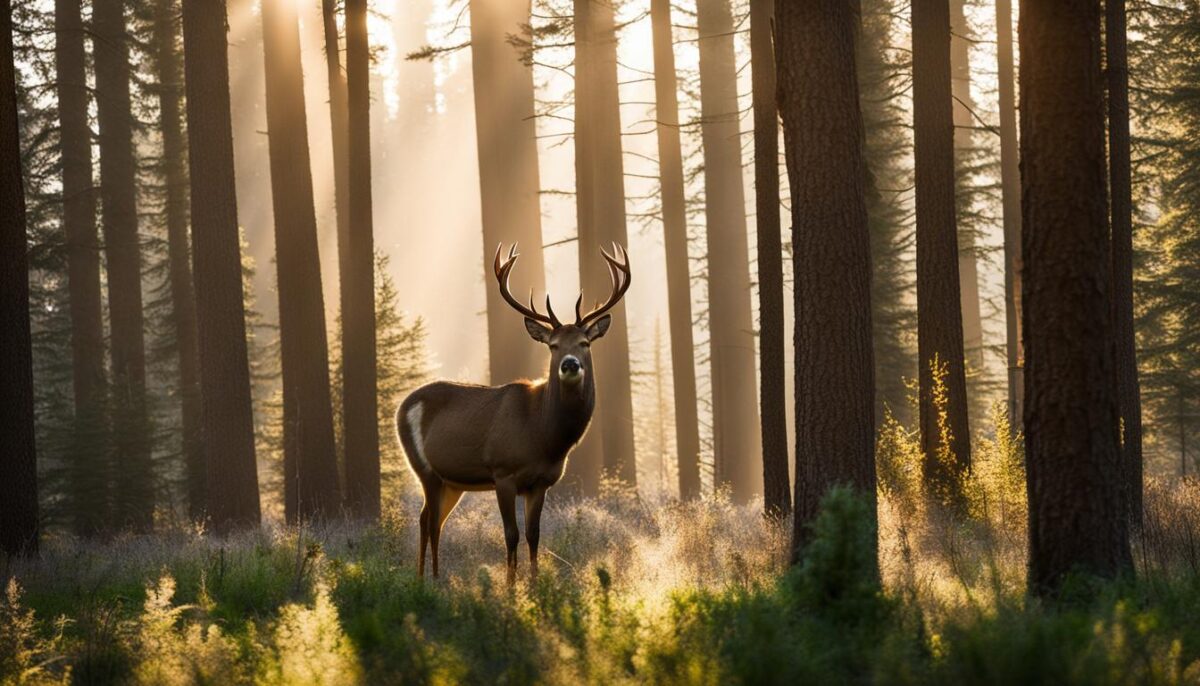
Managing Mule Deer Herds
The management of mule deer herds involves a comprehensive understanding of their reproductive behavior and population dynamics. Wildlife managers rely on population data, including reproductive rates and the gestation period, to make informed decisions about hunting quotas, habitat management, and conservation strategies. By effectively managing mule deer herds, we can ensure the long-term sustainability of these populations and preserve the biodiversity of natural ecosystems.
One of the key aspects of managing mule deer herds is monitoring their reproductive behavior. This includes studying the timing of the breeding season and understanding the factors that influence mule deer reproduction. By collecting data on reproductive rates and gestation periods, wildlife managers can assess the health of the population and determine appropriate management strategies.
Table: Mule Deer Population Management Strategies
| Management Strategy | Description |
|---|---|
| Hunting Quotas | Setting limits on the number of mule deer that can be harvested during hunting seasons helps control the population and maintain a balance between the deer and their habitat. |
| Habitat Management | Ensuring the availability of suitable habitat, including food sources and shelter, is essential for mule deer populations. This may involve activities such as habitat restoration and invasive species control. |
| Conservation Strategies | Implementing conservation initiatives aimed at protecting mule deer populations and their habitats. This may include land preservation, habitat connectivity, and public education programs. |
By implementing these management strategies, wildlife managers can help maintain healthy mule deer populations for future generations. This proactive approach not only benefits the mule deer themselves but also contributes to the overall functioning of ecosystems by ensuring the availability of prey for predators and supporting the ecological balance.
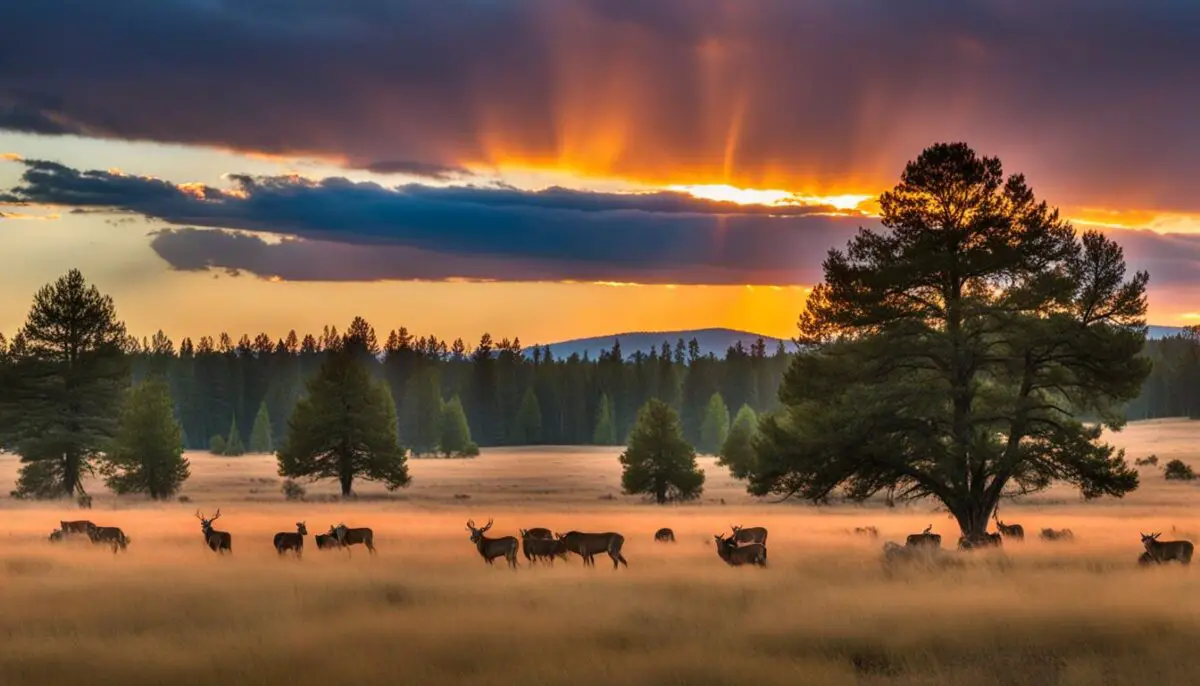
Effective management of mule deer herds is crucial for the long-term conservation of this iconic species. By understanding their reproductive behavior and population dynamics, wildlife managers can make informed decisions that promote the sustainability of mule deer populations and protect the biodiversity of natural habitats.
Conclusion
The mule deer gestation period plays a crucial role in their reproduction and overall population dynamics. Lasting approximately 7 months, this extended period allows for proper fawn development and ensures their survival after birth. Understanding the duration of the gestation period is vital for effective wildlife management and conservation efforts.
By studying mule deer reproductive behavior and factors that influence it, we can make informed decisions to protect and preserve mule deer populations. Habitat quality, food availability, and overall population density are just a few of the factors that can impact mule deer reproduction. Protecting their habitats and implementing sustainable hunting practices are essential for the long-term survival of this iconic species.
Conserving mule deer populations is not just about preserving the species itself. It is about maintaining the balance and biodiversity of our natural ecosystems. Mule deer play a vital role as prey for predators, contributing to a healthy and functioning ecosystem. By prioritizing mule deer conservation, we ensure the beauty and sustainability of our natural world for future generations.
FAQ
What is the gestation period of mule deer?
The gestation period for mule deer is around 7 months.
When does the breeding season for mule deer occur?
The breeding season, or rut, typically occurs in the fall.
What are male mule deer called?
Male mule deer are called bucks.
What are female mule deer called?
Female mule deer are called does.
When do female mule deer give birth to their fawns?
Female mule deer give birth to their fawns in the late spring or early summer.
How long do female mule deer carry their young?
Female mule deer carry their young, known as fawns, for approximately 7 months.
What factors can influence mule deer reproduction?
Habitat quality, food availability, predation, and population density are factors that can influence mule deer reproduction.
How can hunters contribute to mule deer conservation efforts?
Hunters can contribute to mule deer conservation efforts by practicing responsible hunting, following hunting regulations, and providing valuable data and information about mule deer populations.
What is the importance of understanding mule deer reproduction for wildlife management?
Understanding mule deer reproduction is crucial for making informed decisions about habitat management, hunting quotas, and conservation strategies to maintain healthy mule deer populations.
Why is mule deer conservation important?
Conserving mule deer populations ensures the preservation of biodiversity and ecological balance in ecosystems, as well as providing prey for predators and contributing to the overall functioning of the ecosystem.
What are some future research and conservation priorities for mule deer?
Future research could focus on environmental factors impacting mule deer reproduction and the genetic diversity of mule deer populations. Conservation efforts should prioritize protecting mule deer habitats and implementing sustainable hunting practices.


